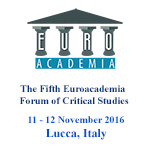Euroacademia Conferences
 Europe Inside-Out: Europe and Europeanness Exposed to Plural Observers (9th Edition) April 24 - 25, 2020
Europe Inside-Out: Europe and Europeanness Exposed to Plural Observers (9th Edition) April 24 - 25, 2020 Identities and Identifications: Politicized Uses of Collective Identities (9th Edition) June 12 - 13, 2020
Identities and Identifications: Politicized Uses of Collective Identities (9th Edition) June 12 - 13, 2020 8th Forum of Critical Studies: Asking Big Questions Again January 24 - 25, 2020
8th Forum of Critical Studies: Asking Big Questions Again January 24 - 25, 2020 Re-Inventing Eastern Europe (7th Edition) December 13 - 14, 2019
Re-Inventing Eastern Europe (7th Edition) December 13 - 14, 2019 The European Union and the Politicization of Europe (8th Edition) October 25 - 26, 2019
The European Union and the Politicization of Europe (8th Edition) October 25 - 26, 2019 Identities and Identifications: Politicized Uses of Collective Identities (8th Edition) June 28 - 29, 2019
Identities and Identifications: Politicized Uses of Collective Identities (8th Edition) June 28 - 29, 2019 The European Union and the Politicization of Europe (7th Edition) January 25 - 26, 2019
The European Union and the Politicization of Europe (7th Edition) January 25 - 26, 2019 7th Forum of Critical Studies: Asking Big Questions Again November 23 - 24, 2018
7th Forum of Critical Studies: Asking Big Questions Again November 23 - 24, 2018 Europe Inside-Out: Europe and Europeanness Exposed to Plural Observers (8th Edition) September 28 - 30, 2018
Europe Inside-Out: Europe and Europeanness Exposed to Plural Observers (8th Edition) September 28 - 30, 2018 Identities and Identifications: Politicized Uses of Collective Identities (7th Edition) June 14 - 15, 2018
Identities and Identifications: Politicized Uses of Collective Identities (7th Edition) June 14 - 15, 2018
Creative Industries in Norway: A Question of Cultural Heritage and Identity
-
-

-
Presentation speakers
- Ekaterina Bagreeva, Russian Economic University of G. V. Plekhanov
Abstract:
Creative industries are a part of the service industries. In his book “The Wealth of Nations” from 1776, Adam Smith argued that service occupations were unproductive. However, the service industry is now the largest sector in modern economies. Within this area, the creative industries have grown faster than the industry in general over the last 15 years, making it interesting even at a national level. Of the nine groups of creative industries defined by the Center of Creative Industries in Norway, the group “cultural heritage and the arts” may be considered challenging with regards to the topic of identity in a country with a history of 500 years of being ruled by others, and the last 50 years with extensive immigration. With this level of foreign influence, the questions of national versus international aspects are valuable inputs for considering the cultural heritage as a resource in the development of the society. The Heritage Cycle (Simon Thurley, 2005) helps analyzing these elements, and describes how the past can become a part of the future through understanding, valuing, caring and enjoying the cultural heritage. In this context, it could be seen as a resource influencing the awareness and content of a national and/or regional identity. Furthermore, these aspects may be used in linking levels of value creation towards both heritage and identity. The presentation highlights the creative industries in Norway country through three case studies: The northern city of Røros, through the assignments of DMC Authenticore, and within a children’s book – “Norway in Miniatures from A to Z”. These examples are used in addressing the big questions of a national cultural heritage and identity, each one on a different level – one city, one company, one book.
-
Related Presentations

Institutionalised Identity
- Karolina Golinowska













